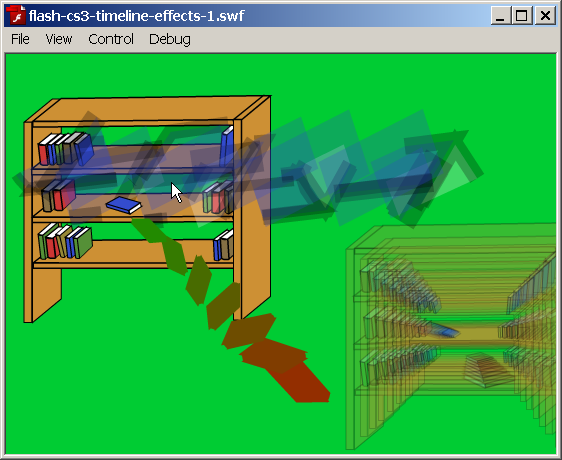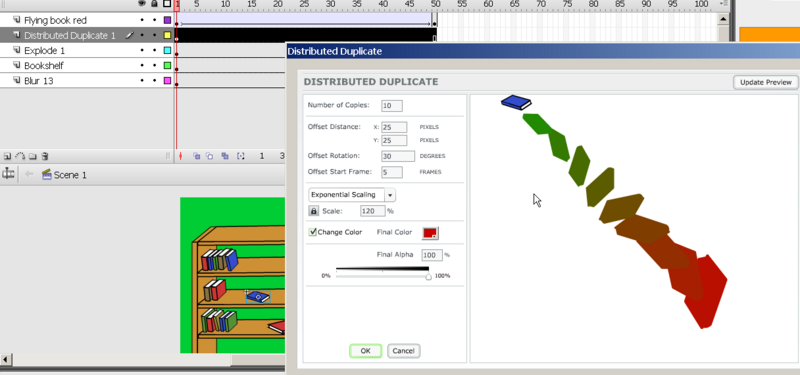Flash CS3 special effects tutorial: Difference between revisions
m (using an external editor) |
m (using an external editor) |
||
| Line 1: | Line 1: | ||
{{Stub}} | {{Stub}} | ||
This is part of [[Flash]] CS3 tutorials. Doesn't contain details, just some short "how to". | |||
This is part of [[Flash]] CS3 tutorials. | |||
; Learning goals: | ; Learning goals: | ||
| Line 27: | Line 22: | ||
: It aims at beginners. More advanced features and tricks are not explained here. | : It aims at beginners. More advanced features and tricks are not explained here. | ||
== Summary == | == Timeline effects == | ||
=== Summary of the procedure === | |||
; Step 1 - Select an object and open the effects tool | ; Step 1 - Select an object and open the effects tool | ||
* Create a new layer | * Create a '''new layer''' | ||
* | * Insert an object (can be most anything for most special effect animations) | ||
* '''Select''' this object | * '''Select''' this object | ||
* Menu ''Insert->Timeline Effects'', | * ''Right-click->Timeline Effects'' or else Menu ''Insert->Timeline Effects'' , then see next step | ||
; Step 2 - Select an effect | ; Step 2 - Select an effect | ||
* Select an effect | * Select an effect and adjust parameters | ||
* You can preview the effect within the Effects tool. | |||
NB: Ignore error warnings about Flash 7 etc. | NB: Ignore error warnings about Flash 7 etc. | ||
| Line 43: | Line 41: | ||
* Right-click on the object: ''Timeline Effects''; ''Remove Effect'' or ''Edit Effect'' | * Right-click on the object: ''Timeline Effects''; ''Remove Effect'' or ''Edit Effect'' | ||
An example is | There are three submenus for effects (I can't see the difference between the first two) | ||
* Assistants | |||
** Copy to Grid (not a timeline effect, just a multiplication of drawing to a grid) | |||
** Distributed Duplicate. Will make "tumbling copies" of an element. | |||
* Effects | |||
** Blur (object will blur and change size in all or one chosen direction) | |||
** Drop Shadow (just draws a static drop shadow) | |||
** Expand (object will expand/shrink) | |||
** Explode (object will explode and draw different fragments on an configurable arc) | |||
* Transform/Transition | |||
** Transform (A shape tween with extra options) | |||
** Transition (A motion tween with extra options) | |||
For each of these effects you can set certain parameters, in particular: | |||
* Number of copies | |||
* Offset and rotation paramters, i.e. where the generated images will display and if/how they rotate | |||
* Offset start frame: Keyframes in which the images will be drawn | |||
'''Important''': Using the special effects means that you can '''not''' change anything Flash will generate. Also, do not make modifications to the object. Flash will: | |||
* rename the layer ('''do not choose a "better" name''') | |||
* add stuff to a Effects Folder in the library | |||
* Add an item to the library | |||
If you want to remove an effect, it is best to ''Right-click->Remove'' on an object ! | |||
You also can delete all the generated objects, but this is more work and you may by mistake delete something else .... | |||
==== An example ==== | |||
The following (ugly) example contains three effects: | |||
* '''Distributed duplicate''' (tumbling) | |||
* '''Explode''' | |||
* '''Blur''' | |||
[[image:flash-cs3-timeline-effects.png|frame|none|Timeline effects example]] | |||
To edit each animation, you will get a menu like this and you have to play with the parameters until you get it right. Remember that you can not make any changes to the object or the generated objects (except using the ''right-click->Timeline Effects'' menu ! | |||
[[image:flash-cs3-timeline-effects-distributed-duplicate.png|thumb|800px|none|Distributed duplicate timeline effect]] | |||
An other example that uses tumbling is this "enhanced" video. | |||
* [http://tecfa.unige.ch/guides/flash/ex/component-video-intro/flash-cs3-video-timeline-embedd.html flash-cs3-video-timeline-embedd.html] | * [http://tecfa.unige.ch/guides/flash/ex/component-video-intro/flash-cs3-video-timeline-embedd.html flash-cs3-video-timeline-embedd.html] | ||
* Grab the source from: | * Grab the source from: | ||
Revision as of 15:18, 8 October 2007
This is part of Flash CS3 tutorials. Doesn't contain details, just some short "how to".
- Learning goals
- Learn how to add special effects to animations
- Prerequisites
- Flash CS3 desktop tutorial
- Flash drawing tutorial
- Flash object transform tutorial
- Flash colors tutorial
- Flash frame-by-frame animation tutorial
- Flash motion tweening tutorial (for the rocket launcher)
- Moving on
- The Flash article has a list of other tutorials.
- Quality
- This text should technical people get going and may not be good enough for self-learning beginners. It can be used as handout in a "hands-on" class. That is what Daniel K. Schneider made it for...
- Level
- It aims at beginners. More advanced features and tricks are not explained here.
Timeline effects
Summary of the procedure
- Step 1 - Select an object and open the effects tool
- Create a new layer
- Insert an object (can be most anything for most special effect animations)
- Select this object
- Right-click->Timeline Effects or else Menu Insert->Timeline Effects , then see next step
- Step 2 - Select an effect
- Select an effect and adjust parameters
- You can preview the effect within the Effects tool.
NB: Ignore error warnings about Flash 7 etc.
- Step 3 - Start over
- Right-click on the object: Timeline Effects; Remove Effect or Edit Effect
There are three submenus for effects (I can't see the difference between the first two)
- Assistants
- Copy to Grid (not a timeline effect, just a multiplication of drawing to a grid)
- Distributed Duplicate. Will make "tumbling copies" of an element.
- Effects
- Blur (object will blur and change size in all or one chosen direction)
- Drop Shadow (just draws a static drop shadow)
- Expand (object will expand/shrink)
- Explode (object will explode and draw different fragments on an configurable arc)
- Transform/Transition
- Transform (A shape tween with extra options)
- Transition (A motion tween with extra options)
For each of these effects you can set certain parameters, in particular:
- Number of copies
- Offset and rotation paramters, i.e. where the generated images will display and if/how they rotate
- Offset start frame: Keyframes in which the images will be drawn
Important: Using the special effects means that you can not change anything Flash will generate. Also, do not make modifications to the object. Flash will:
- rename the layer (do not choose a "better" name)
- add stuff to a Effects Folder in the library
- Add an item to the library
If you want to remove an effect, it is best to Right-click->Remove on an object ! You also can delete all the generated objects, but this is more work and you may by mistake delete something else ....
An example
The following (ugly) example contains three effects:
- Distributed duplicate (tumbling)
- Explode
- Blur
To edit each animation, you will get a menu like this and you have to play with the parameters until you get it right. Remember that you can not make any changes to the object or the generated objects (except using the right-click->Timeline Effects menu !
An other example that uses tumbling is this "enhanced" video.
- flash-cs3-video-timeline-embedd.html
- Grab the source from:

